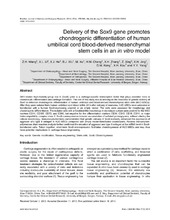| dc.contributor.author | Wang, Zhenghui | en_US |
| dc.contributor.author | Li, Xiaoli | en_US |
| dc.contributor.author | He, Xijing | en_US |
| dc.contributor.author | Wu, Baojun | en_US |
| dc.contributor.author | Xu, Min | en_US |
| dc.contributor.author | Chang, Huimin | en_US |
| dc.contributor.author | Zhang, Xianghong | en_US |
| dc.contributor.author | Xing, Zhe | en_US |
| dc.contributor.author | Jing, Xiaohong | en_US |
| dc.contributor.author | Kong, Demin | en_US |
| dc.contributor.author | Kou, Xiaohui | en_US |
| dc.contributor.author | Yang, Y.Y. | en_US |
| dc.date.accessioned | 2015-10-06T09:01:46Z | |
| dc.date.available | 2015-10-06T09:01:46Z | |
| dc.date.issued | 2014-04 | |
| dc.Published | Brazilian journal of medical and biological research 2014, 47(4):279-286 | eng |
| dc.identifier.issn | 1414-431X | |
| dc.identifier.uri | https://hdl.handle.net/1956/10547 | |
| dc.description.abstract | SRY-related high-mobility-group box 9 (Sox9) gene is a cartilage-specific transcription factor that plays essential roles in chondrocyte differentiation and cartilage formation. The aim of this study was to investigate the feasibility of genetic delivery of Sox9 to enhance chondrogenic differentiation of human umbilical cord blood-derived mesenchymal stem cells (hUC-MSCs). After they were isolated from human umbilical cord blood within 24 h after delivery of neonates, hUC-MSCs were untreated or transfected with a human Sox9-expressing plasmid or an empty vector. The cells were assessed for morphology and chondrogenic differentiation. The isolated cells with a fibroblast-like morphology in monolayer culture were positive for the MSC markers CD44, CD105, CD73, and CD90, but negative for the differentiation markers CD34, CD45, CD19, CD14, or major histocompatibility complex class II. Sox9 overexpression induced accumulation of sulfated proteoglycans, without altering the cellular morphology. Immunocytochemistry demonstrated that genetic delivery of Sox9 markedly enhanced the expression of aggrecan and type II collagen in hUC-MSCs compared with empty vector-transfected counterparts. Reverse transcription-polymerase chain reaction analysis further confirmed the elevation of aggrecan and type II collagen at the mRNA level in Sox9-transfected cells. Taken together, short-term Sox9 overexpression facilitates chondrogenesis of hUC-MSCs and may thus have potential implications in cartilage tissue engineering. | en_US |
| dc.language.iso | eng | eng |
| dc.publisher | SciELO | eng |
| dc.rights | Attribution CC BY | eng |
| dc.rights.uri | http://creativecommons.org/licenses/by/4.0/ | eng |
| dc.subject | Genetic modification | eng |
| dc.subject | Tissue engineering | eng |
| dc.subject | Stem cells | eng |
| dc.subject | Sox9 | eng |
| dc.subject | Chondrogenesis | eng |
| dc.title | Delivery of the Sox9 gene promotes chondrogenic differentiation of human umbilical cord blood-derived mesenchymal stem cells in an in vitro model | en_US |
| dc.type | Peer reviewed | |
| dc.type | Journal article | |
| dc.date.updated | 2015-07-28T09:51:33Z | |
| dc.description.version | publishedVersion | en_US |
| dc.rights.holder | Copyright 2014 The Authors | |
| dc.identifier.doi | https://doi.org/10.1590/1414-431x20133539 | |
| dc.identifier.cristin | 1152534 | |
| dc.subject.nsi | VDP::Medisinske fag: 700::Basale medisinske, odontologiske og veterinærmedisinske fag: 710::Medisinsk genetikk: 714 | |
| dc.subject.nsi | VDP::Midical sciences: 700::Basic medical, dental and veterinary sciences: 710::Medical genetics: 714 | |

